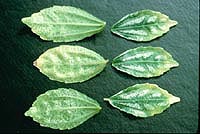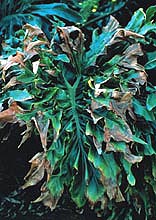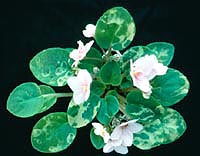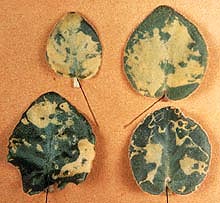
Fig. 2. Edema on Pilea cadierei. (Click image for expanded view). |
|
Imbalances in water result in classic symptoms of stress in many foliage plants. Some plants readily develop edema (swelling caused by excessive moisture, occurring as numerous small bumps on the lower side of leaves or on stems) when temperatures are low and soil moisture is high (Figs. 1 and 2). Others are more prone to wilt or to necrosis or abscission of leaves when irrigation is withheld (Fig. 3). In other plants, water deficits are only obvious when the foliage loses its normal color.
|

Fig. 3. Drought symptoms on a large Philodendron selloum. (Click image for expanded view). |
|
|

Fig. 4. Cold water damage on African violet. (Click image for expanded view). |
Leaf spot caused by cold irrigation water at high air temperatures has been a serious problem for growers of Saintpaulia ionantha H. Wendl. (African violet) since at least 1942. Symptoms of this disease are lesions or ring spots of chlorotic tissue on the upper surface of leaves (Figs. 4 and 5). The lesions are first water-soaked but rapidly turn white or necrotic. They are occasionally confused with symptoms of a viral disease. In plants irrigated with water held at 5ºC, the damage increased as the air temperature increased. The plants seemed to be sensitive to air temperatures of 10-25ºC when the water was 5ºC. Water temperatures of 10 and 15ºC did not damage plants held at 15ºC. The difference between the air temperature and the water temperature has been identified as the causal agent. When both temperatures are low, even a small difference is sufficient to cause damage. Warmer water does not damage African violet leaves, even when they are quite hot.
|

Fig. 5. Cold water injury to foliage of African violet. From the Compendium of Flowering Potted Plant Diseases. |
|
Excess water results in edema of some foliage plants under some conditions. Symptoms are small, blister-like areas on the underside of affected leaves (Fig. 1). The lesions may be concentrated around the leaf margins and, viewed by transmitted light, are lighter in color than the surrounding areas of the leaf. High levels of light, low levels of nutrients, and high soil moisture each contribute to the development of edema in Pelargonium X hortorum L. H. Bailey (zonal geranium). Other foliage plants that sometimes develop edema are Brassaia, Dracaena, Fatshedera, Peperomia, and Polyscias. Different cultivars in some plant groups differ significantly in susceptibility. In Florida, edema is least severe during the summer, from June through September.
Water deficits can severely damage cuttings of some plants. Water stress causes a leaf spot of Ficus elastica Roxb. ex Hornem. (India-rubber tree) grown under full-sun conditions. Lesions form on the lower surface of recently matured leaves and are most severe when plants are under moisture stress from air layering or insufficient irrigation. During propagation, cuttings of Dieffenbachia spp. are especially sensitive to desiccation. Slight to severe loss of lower foliage is common when plants undergo water deficits. Sometimes irregularly shaped leaf lesions form and are rapidly invaded by saprophytic fungi and bacteria. In these cases, the lesions may continue to expand because of the growth of the microorganisms.
Leaf abscission is one of the most obvious symptoms of water stress in F. benjamina L. (weeping fig). Transplanting from the field into a container often results in leaf abscission, since the root system is radically reduced. Leaf drop also occurs in the interiorscape when the frequency or amount of irrigation is insufficient. Minimizing transpiration helps to reduce leaf abscission.
Selected References
Blage, R. J., Struckmeyer, B. E., and Beck, G. E. 1969. Occurrence, severity and nature of oedema in Pelargonium hortorum Ait. J. Am. Soc. Hortic. Sci. 94:181-183.
Broschat, T. K., and Donselman, H. M. 1981. Effects of light intensity, air layering, and water stress on leaf diffusive resistance and incidence of leaf spotting in Ficus elastica. HortScience 16(2):211-212.
Conover, C. A., and Poole, R. T. 1974. Foliage collapse of Dieffenbachia picta 'Perfection' during propagation. SNA Res. J. l(l):1-6.
Metwally, A. W., Beck, G. E., and Struckmeyer, B. E. 1970. The role of water and cultural practices on oedema of Pelargonium hortorum Ait. J. Am. Soc. Hortic. Sci. 95:808-813.
Peterson, J. C., Sacalis, J. N., and Durkin, D. J. 1980. Promotion of leaf abscission in intact Ficus benjamina by exposure to water stress. J. Am. Soc. Hortic. Sci. 105(6):788-793.
RETURN TO APSnet FEATURE STORY
